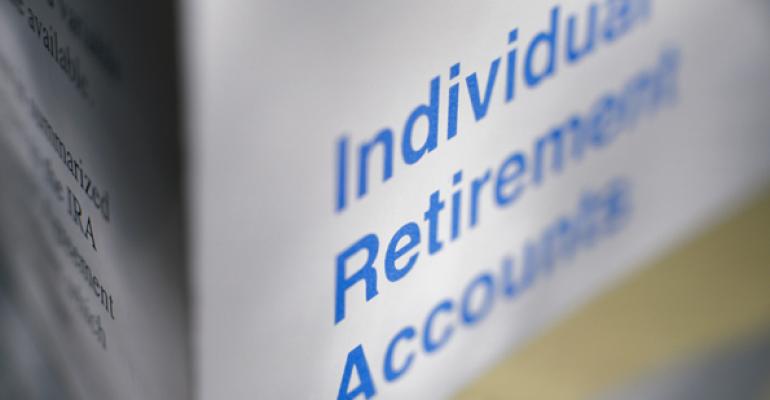When the surviving spouse of an individual retirement account owner or qualified retirement plan participant is named as beneficiary, it’s often taken for granted that the surviving spouse should roll over the decedent’s retirement benefits to an IRA treated as an IRA of the surviving spouse. That’s not always so.
In that same vein, it may be wise to avoid making an election, including a passive election, to treat a deceased spouse’s IRA as an IRA of the surviving spouse. Such an election is made, consciously or inadvertently, by failing to withdraw a minimum required distribution from the deceased spouse’s IRA.
Five-Year Rule
The first concern in post-death IRA planning might be to avoid subjecting the entire qualified plan benefit or IRA to income taxes in the near term under the dreaded “5-year rule.” For example, if an account owner dies during 2018 without reaching his required beginning date (April 1 of the year following the year in which the account owner attained age 70½), all retirement benefits must be distributed by Dec. 31, 2023. To avoid application of that rule, an IRA or qualified retirement account death beneficiary generally must begin taking RMDs by Dec. 31 of the year after the year when the IRA owner or plan participant dies.1
But, a surviving spouse is never subject to the 5-year rule.2 Instead, a surviving spouse must begin taking RMDs on or before the end of the calendar year immediately following the calendar year in which the IRA owner or plan participant died; or, if later, the end of the calendar year in which the IRA owner or plan participant would’ve attained age 70½.
For example, George is named beneficiary of Rhonda’s IRA. Rhonda was born Nov. 27, 1966 and died on Jan. 12, 2018. George was born May 6, 1964. Rhonda, the younger of the couple, would’ve attained age 70½ on May 27, 2037. As a result, George’s required commencement date (the last day when George, as beneficiary, must begin taking RMDs) is Dec. 31, 2037.
Every year, George must look up his applicable distribution period in the single life table, based on his attained age, unless he elects to treat Rhonda’s IRA as his own.3
Spousal Election
A surviving spouse is treated as having elected to treat a deceased spouse’s IRA as an IRA of the surviving spouse if the surviving spouse misses an RMD that must be paid to the surviving spouse as beneficiary.4 Because a surviving spouse is never subject to the 5-year rule, George can’t be said to have elected to treat Rhonda’s IRA as his own by reason of violating the 5-year rule.
George will attain age 70½ during 2034. If George elects to treat Rhonda’s IRA as his own before 2036 (the year when Rhonda would’ve reached age 70½), he can’t wait until 2037 to begin taking RMDs. Instead, by Apr. 1, 2035, he’ll have to take his first RMD with respect to 2034.
Once George reaches the time when RMDs from the inherited IRA must begin, George should consider a rollover to an IRA of his own, that is, an IRA that’s no longer an inherited IRA. Doing so is an election to treat the Rhonda’s IRA as an IRA George.5 In the calendar year of the election and in each subsequent calendar year, RMDs are determined based on George being treated as the IRA’s owner, rather than as beneficiary.6
That election will lower RMDs because the uniform table that applies to spousal rollover IRAs produces lower RMDs than the single life table that applies to inherited IRAs.
After George Dies
George should take care to set up either a rollover IRA or a beneficiary IRA, and he should be sure to name a death beneficiary, which avoids his estate.
How must the beneficiary of George’s inherited IRA take RMDs when George dies?
The answer depends on whether George elected to treat Rhonda’s IRA as his own. That election can occur either because George opens an IRA in his own name and rolls over Rhonda’s IRA, or because George fails to take an RMD in his role as beneficiary of Rhonda’s IRA.7
If George dies with Rhonda’s inherited IRA before his required commencement date, he’s treated as though he was the IRA owner.8
If George dies before attaining age 70½, but doesn’t elect to treat Rhonda’s IRA as his own, RMDs apply as if George were the IRA owner instead of Rhonda.9 Assuming George has appointed a successor beneficiary, that successor beneficiary must either comply with the 5-year rule, measured from George’s date of death or begin taking RMDs over the successor beneficiary’s life expectancy if begun by Dec. 31 of the year after George’s death. If George rolls over Rhonda’s account, the result is the same.
If George dies after age 70 ½, but before his required commencement date, the account is still treated as an account of George, but the 5-year rule no longer applies. The next beneficiary in line must take distributions as the beneficiary of an IRA of George.
If George remarries, has elected the special spousal rule for Rhonda’s IRA and later dies survived by his new spouse, the special rule for spouses can’t be applied to George’s inherited (from Rhonda) IRA.10
Endnotes
1. Internal Revenue Code § 401(a)(9)(B)(ii) and (iii).
2. IRC § 401(a)(9)(B)(iv); Treasury Regulations § 1.401(a)(9)-3, Q&A-3(b).
3. Treas. Regs. § 1.401(a)(9)-5, Q&A-5(c)(2).
4. Treas. Regs. § 1.408-8, Q&A-5(b)(i).
5. Ibid.
6. Treas. Regs. § 1.408-8, Q&A-5(a).
7. Treas. Regs. § 1.408-8, Q&A-5.
8. Treas. Regs. § 1.401(a)(9)-3, Q&A-5.
9. Ibid.
10. IRC § 1.401(a)(9)(B)(iv)(II).





